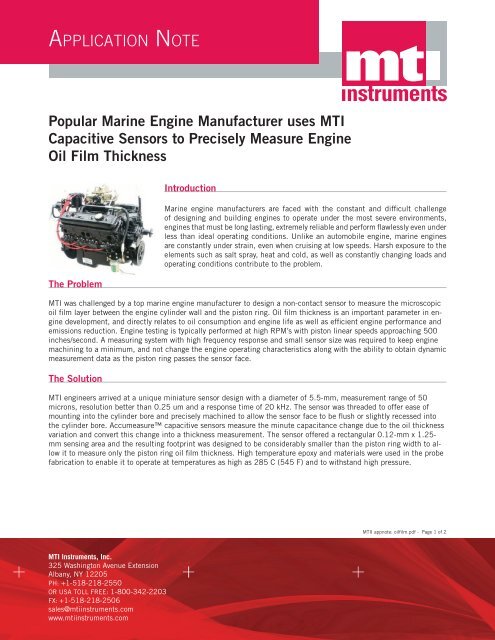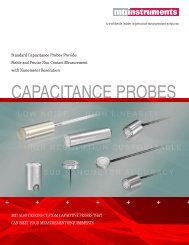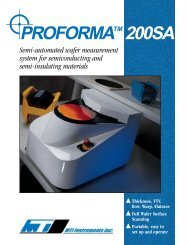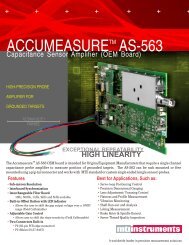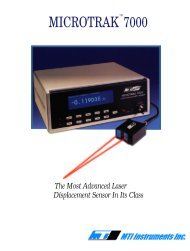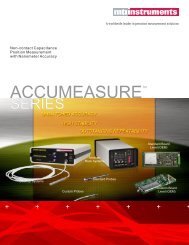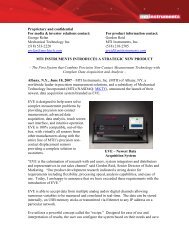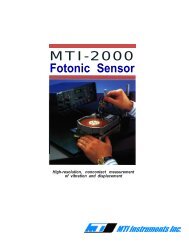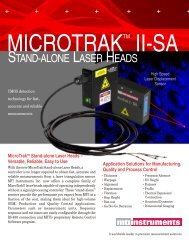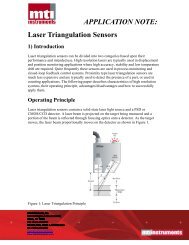APPLICATION NOTE - MTI Instruments Inc.
APPLICATION NOTE - MTI Instruments Inc.
APPLICATION NOTE - MTI Instruments Inc.
You also want an ePaper? Increase the reach of your titles
YUMPU automatically turns print PDFs into web optimized ePapers that Google loves.
<strong>APPLICATION</strong> <strong>NOTE</strong><br />
Popular Marine Engine Manufacturer uses <strong>MTI</strong><br />
Capacitive Sensors to Precisely Measure Engine<br />
Oil Film Thickness<br />
The Problem<br />
Introduction<br />
Marine engine manufacturers are faced with the constant and difficult challenge<br />
of designing and building engines to operate under the most severe environments,<br />
engines that must be long lasting, extremely reliable and perform flawlessly even under<br />
less than ideal operating conditions. Unlike an automobile engine, marine engines<br />
are constantly under strain, even when cruising at low speeds. Harsh exposure to the<br />
elements such as salt spray, heat and cold, as well as constantly changing loads and<br />
operating conditions contribute to the problem.<br />
<strong>MTI</strong> was challenged by a top marine engine manufacturer to design a non-contact sensor to measure the microscopic<br />
oil film layer between the engine cylinder wall and the piston ring. Oil film thickness is an important parameter in engine<br />
development, and directly relates to oil consumption and engine life as well as efficient engine performance and<br />
emissions reduction. Engine testing is typically performed at high RPM’s with piston linear speeds approaching 500<br />
inches/second. A measuring system with high frequency response and small sensor size was required to keep engine<br />
machining to a minimum, and not change the engine operating characteristics along with the ability to obtain dynamic<br />
measurement data as the piston ring passes the sensor face.<br />
The Solution<br />
<strong>MTI</strong> engineers arrived at a unique miniature sensor design with a diameter of 5.5-mm, measurement range of 50<br />
microns, resolution better than 0.25 um and a response time of 20 kHz. The sensor was threaded to offer ease of<br />
mounting into the cylinder bore and precisely machined to allow the sensor face to be flush or slightly recessed into<br />
the cylinder bore. Accumeasure capacitive sensors measure the minute capacitance change due to the oil thickness<br />
variation and convert this change into a thickness measurement. The sensor offered a rectangular 0.12-mm x 1.25-<br />
mm sensing area and the resulting footprint was designed to be considerably smaller than the piston ring width to allow<br />
it to measure only the piston ring oil film thickness. High temperature epoxy and materials were used in the probe<br />
fabrication to enable it to operate at temperatures as high as 285 C (545 F) and to withstand high pressure.<br />
<strong>MTI</strong>I appnote: oilfilm.pdf - Page 1 of 2<br />
<strong>MTI</strong> <strong>Instruments</strong>, <strong>Inc</strong>.<br />
325 Washington Avenue Extension<br />
Albany, NY 12205<br />
PH: +1-518-218-2550<br />
OR USA TOLL FREE: 1-800-342-2203<br />
FX: +1-518-218-2506<br />
sales@mtiinstruments.com<br />
www.mtiinstruments.com
The Equipment<br />
<strong>MTI</strong>’s proven Accumeasure 5000 precision high frequency dual channel amplifier with<br />
20 kHz response time proved an ideal choice for the task. Because of the high frequency<br />
response required for the application, <strong>MTI</strong> engineers designed a custom amplifier filter, which<br />
eliminated signal overshoot and resulted in minimal phase delay in the electronics.<br />
Other Applications<br />
<strong>MTI</strong> Accumeasure sensors can also be used in other applications such as determining the ratio of oil/air present in an<br />
engine passage. The Accumeasure equipment provides a distinct voltage output, depending upon whether oil, air or<br />
a mixture of both (foam) is present. The system works equally well in transmission research to determine the amount<br />
of cavitation in the fluid. Any foaming of the fluid indicates air is present in the mixture and will cause a noticeable<br />
change in the output signal. This type of data proves to be invaluable in determining the effect of mixing various additives<br />
into transmission fluids and the resultant knowledge helps researchers in designing a superior, longer lasting<br />
product.<br />
Benefits<br />
If you have a demanding noncontact sensing requirement contact <strong>MTI</strong>’s team of experienced application specialists<br />
who will thoroughly and accurately analyze your requirements and provide you a practical, yet cost effective solution.<br />
<strong>MTI</strong>I appnote: oilfilm.pdf - Page 2 of 2<br />
sales@mtiinstruments.com • www.mtiinstruments.com


